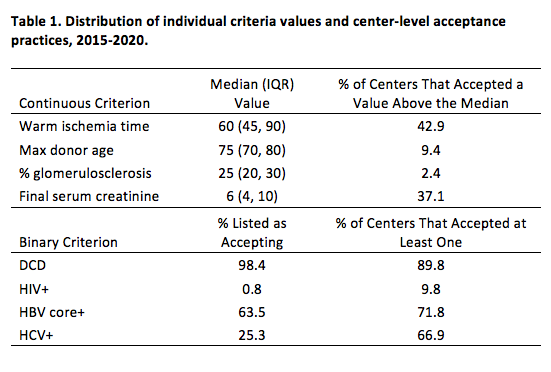Improving Efficiency in Kidney Distribution: A Comparison of UNet Deceased Donor Criteria to Actual Kidney Acceptance Practices
Johns Hopkins University, Baltimore, MD
Meeting: 2022 American Transplant Congress
Abstract number: 710
Keywords: Allocation, Kidney transplantation
Topic: Clinical Science » Kidney » 31 - Kidney Deceased Donor Allocation
Session Information
Session Name: Kidney Deceased Donor Allocation
Session Type: Poster Abstract
Date: Saturday, June 4, 2022
Session Time: 5:30pm-7:00pm
 Presentation Time: 5:30pm-7:00pm
Presentation Time: 5:30pm-7:00pm
Location: Hynes Halls C & D
Session Information
Session Time: 7:00pm-8:00pm
 Presentation Time: 7:00pm-8:00pm
Presentation Time: 7:00pm-8:00pm
Location: Hynes Hall C
*Purpose: Efficient utilization of UNet deceased-donor criteria could help streamline kidney allocation by reducing the number of unwanted offers made to transplant centers. We compared center-specified donor criteria to actual donor acceptance practices in order to identify potential areas of inefficiency.
*Methods: Using data from SRTR, we estimated the distribution of donor criteria values among kidney waitlist registrants 2015-2020. We also compared each center’s specified criteria to its accepted kidney offers; offers from donors whose criteria exceeded the maximum value accepted by the center (e.g., donor age> maximum age accepted) were considered surplus.
*Results: A minority (<50%) of centers accepted organs with criteria above the median indicated for all waitlisted candidates for warm ischemia time, age, glomerulosclerosis, and creatinine (Table 1). DCD acceptance was common, with 98.4% of individuals listed as accepting of DCD kidneys and 89.8% of centers accepting at least one kidney from a DCD donor (Table 1). For criteria related to positive HIV, hepatitis B, and hepatitis C status, a smaller percentage of individuals were listed as accepting as compared to the percentage of centers that had accepted organs meeting these criteria (Table 1). A total of 43,875 offers were considered surplus as they exceeded the maximum of at least one criterion accepted by the center receiving the offer. Among 234 transplant centers receiving offers, the median number of surplus offers was 96 (IQR: 38, 247); however, 23 centers received at least 500 surplus offers during the study period (Figure 1).
*Conclusions: Thousands of kidney offers are made to transplant centers that are unlikely to accept them based on their acceptance practices from 2015 to 2020, and the distribution of surplus offers across transplant centers suggests that some centers use these criteria more effectively than others. Directing offers of marginal kidneys to centers that actually transplant them may reduce administrative burden, CIT, and discard.
To cite this abstract in AMA style:
Zeiser LB, Ruck J, Segev D, Massie A. Improving Efficiency in Kidney Distribution: A Comparison of UNet Deceased Donor Criteria to Actual Kidney Acceptance Practices [abstract]. Am J Transplant. 2022; 22 (suppl 3). https://atcmeetingabstracts.com/abstract/improving-efficiency-in-kidney-distribution-a-comparison-of-unet-deceased-donor-criteria-to-actual-kidney-acceptance-practices/. Accessed December 25, 2025.« Back to 2022 American Transplant Congress


